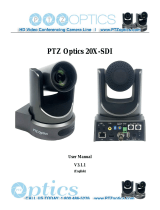
Table of Contents
3
Table of Contents
Getting Started
Precautions ............................................................. 5
Phenomena Specific to CMOS Image Sensors .... 6
Overview
Features .................................................................. 7
System Components .............................................. 8
Supplied Components and Accessories .............. 8
Optional Products ............................................... 9
System Configuration .......................................... 10
Operating a BRC-Z330 Camera Using the
Supplied Remote Commander ....................... 10
Operating a BRC-Z330 Camera Using the RM-
BR300 Remote Control Unit .......................... 10
Operating Multiple BRC-Z330 Cameras Using the
RM-BR300 Remote Control Unit .................. 11
Operating Multiple BRC-Z330 Cameras Using the
BRS-200 Remote Camera Operating
Switcher .......................................................... 12
Location and Function of Parts .......................... 13
Camera ............................................................. 13
Remote Commander (supplied) ....................... 15
RM-BR300 Remote Control Unit (not
supplied) ......................................................... 16
BRBK-HD2 HD-SDI Output Card (not
supplied) ......................................................... 19
Adjusting and Setting With Menus
About On-Screen Menus ..................................... 20
Main Menu ....................................................... 20
Setting Menus ................................................... 20
Operation Through Menus ................................. 21
Menu Operation Using the Supplied Remote
Commander .................................................... 21
Menu Operation Using the RM-BR300 Remote
Control Unit ................................................... 22
EXPOSURE Menu .............................................. 23
COLOR Menu ..................................................... 24
PICTURE Menu .................................................. 25
FOCUS Menu ...................................................... 26
PAN TILT ZOOM Menu .................................... 27
SYSTEM Menu .................................................... 28
VIDEO OUT Menu ............................................. 29
STATUS Menu ..................................................... 30
Operation Using the Supplied
Remote Commander
Turning on the Power ..........................................31
Pan/Tilt and Zoom Operation .............................32
Panning and Tilting ...........................................32
Zooming ............................................................33
Operating Multiple Cameras with the Remote
Commander .....................................................33
Adjusting the Camera ..........................................33
Focusing on a Subject .......................................33
Shooting with Back Lighting ............................34
Storing the Camera Settings in Memory
– Presetting Feature .............................................34
Operation Using the RM-BR300
Remote Control Unit
Turning on the Power ..........................................36
Operating Multiple Cameras .............................36
Pan/Tilt and Zoom Operation .............................37
Panning and Tilting ...........................................37
Zooming ............................................................39
Adjusting the Camera ..........................................39
Focusing on a Subject .......................................39
Shooting with Back Lighting ............................40
Adjusting the White Balance ............................40
Adjusting the Brightness ...................................40
Storing the Camera Settings in Memory
– Presetting Feature .............................................41
Storing Camera Settings ...................................41
Setting the Speed of the Camera Moving to a
Preset Position ................................................42
Installation and Connections
Installation ............................................................43
Attaching an Output Card .................................43
Installing the Camera ........................................43
Installing the Camera in a High Position ..........44
Connections ..........................................................51
Connecting to an AC Outlet ..............................51
Connecting the RM-BR300 Remote Control
Unit .................................................................51
Connecting a Monitor, etc. Equipped with the
Analog Component (YPbPr) Input
Connector ........................................................52
Connecting a Device Equipped with VISCA RS-
232C Connector ..............................................53
Connecting a Device Equipped with VISCA RS-
422 Connector .................................................53





















